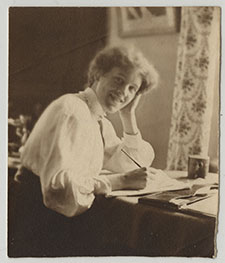Biographers can often be the first people to look at an archival collection in detail. Stephen Roskill, Archives Scholar of Churchill Archives fame, was one of the first people to submerge himself in the collections of Maurice Hankey (1877-1963), 1st Baron Hankey.
After a career in the navy, Hankey moved into Whitehall, working as the Naval Assistant Secretary to the committee of the Imperial Defence before becoming the Secretary of the War Cabinet. Hankey was also the first ever Cabinet Secretary.
Correspondence surviving in Roskill’s archive showcase what was involved in writing a biography when family members, in this case, Maurice’s wife, Adeline, and their children Robin and Ursula were still alive.
Roskill, Adeline and Robin were frequently in correspondence about the 3-part biography. Roskill invited Adeline to read over chapters and, in some cases, to provide photos.
As well as official papers charting his career, Adeline also sent across private letters exchanged with her husband, which Roskill read and extracted the most ‘serviceable’ parts for his biography.
Writing a biography while family members were still alive was occasionally tricky for Roskill. His correspondence with Adeline records her concern over Roskill’s publication of her husband’s criticisms of certain work colleagues, and Roskill’s attempts to alleviate her worries.
Roskill sent Adeline a letter on 20th July 1970 re-emphasising the conditions on which he decided to write the biography: namely that he would have access to all papers, would retain sole editorial rights, and not collude with the family on censorship. For a brief period, Roskill shifted his efforts from working on Hankey’s biography to his history of Naval Policy between the wars.
The seriousness of the letter sparked Robin to respond 5 days later, apologising on his mother’s behalf about the number of comments she made on Roskill’s manuscript; ‘she had not realised at all the seriousness of what she had done to the manuscript’.
Reading Roskill and the Hankeys’ collections together at Churchill Archives reveals the emotional labour which goes into writing a life and the competing agendas which a biographer has to manage.

Photograph of Adeline Hankey at her writing desk, c. 1910s-20s. Source: AHKY 3/1/4,Churchill Archives Centre.
Find out more about:
- The collections of Stephen Roskill, alongside Adeline and Maurice Hankey at Churchill Archives Centre.
- Maurice Hankey in Stephen Roskill’s Hankey: man of secrets. 3 vols. London: Collins, 1970-1974.
- Autobiography as a genre, by reading “Mimesis: The Dramatic Lineage of Auto/Biography.” In Essays on Life Writing: From Genre to Critical Practice, edited by Kadar Marlene, 195-212. Toronto; Buffalo; London: University of Toronto Press, 1992.
Other biographical material in our collections:
- Biography “Rebel Advocate” and Correspondence, 1983, GARD 9. “Rebel Advocate” by Muriel Box (Lady Gardiner) and correspondence, mainly public and political.
- The Onslows and the Royal Navy, ONSS. A typescript biographical work about the naval careers of various members of the Onslow family including Admiral Sir Richard Onslow, Captain Richard Francis John Onslow and Admiral Sir Richard George Onslow which includes a chapter about two ships named HMS Onslow.
- Memoir of Victor Rothschild, 1976-1994, WARN 2. Suzanne Reeve wrote a memoir of Victor Rothschild for the series “Biographical Memoirs of the Fellows of the Royal Society”, 1993.
- ‘Kinnock: the biography, 1998-2001, KNNK AS 2. Material relating to Kinnock’s biography by Martin Westlake with Ian St John (Little, Brown, London, 2001).
- ‘The Story of my Family’, 2008, HMTN 4/1. History of the Adamson family, with a chapter devoted to Mary Agnes Hamilton, researched and compiled by Commander Robert V. Adamson.
- Interview with Lady Soames about the publication of ‘Clementine Churchill, the biography of a marriage, 1980’, MCHL 12/2/13. Interview for the Broadcasting Foundation of America, on Lady Soames’s biography of her mother.
If we’ve whetted your appetite, then do get in touch to explore our collections.
Want to catch up with earlier posts in our series? Check out our blog on autobiographies.
Looking for useful introductions for working with life writing? Here’s some of our favourites:
- Dobson, Miriam, and Benjamin Ziemann, eds. Reading primary sources: the interpretation of texts from nineteenth and twentieth century history. Routledge, 2020.
- Barber, Sarah, and Corinna Peniston-Bird, eds. History beyond the text: a student’s guide to approaching alternative sources. Routledge, 2013.
- Summerfield, Penny. Histories of the self: Personal narratives and historical practice. Routledge, 2018.
- Saunders, Valerie, “Life Writing”. In Victorian Literature, (accessed 4 Aug. 2021).
By Cherish Watton, Archives Assistant.
Subscribe to Churchill Archives Centre News
Enter your email address:
Subscribe to the Churchill Archives News RSS feed:
